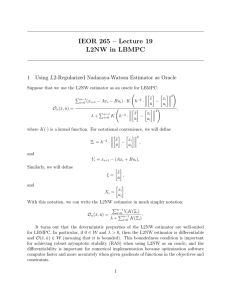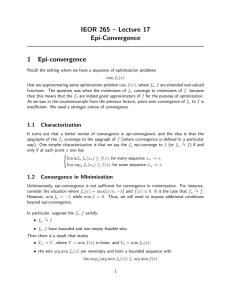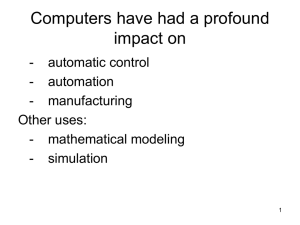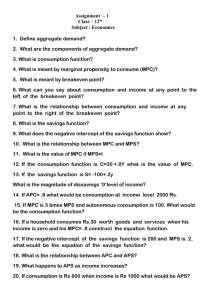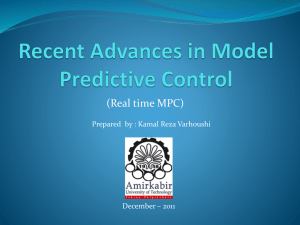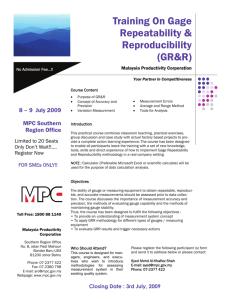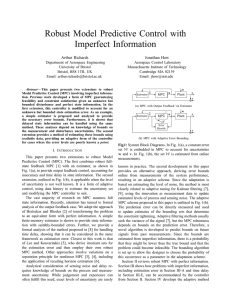Document 10783049
advertisement
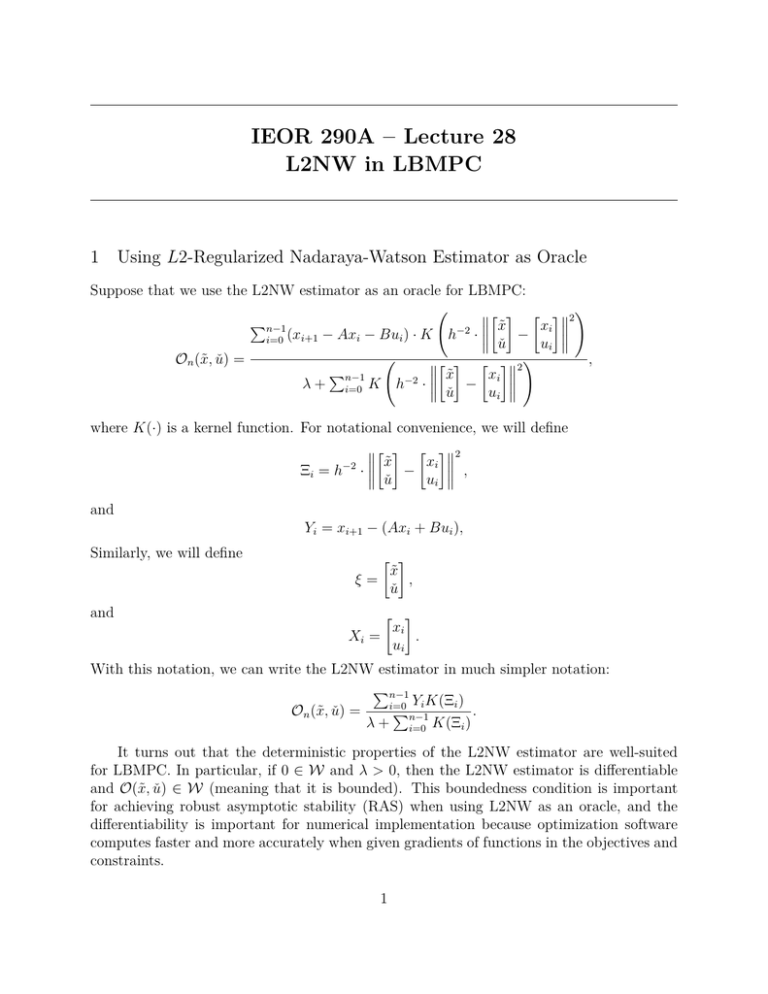
IEOR 290A – Lecture 28
L2NW in LBMPC
1
Using L2-Regularized Nadaraya-Watson Estimator as Oracle
Suppose that we use the L2NW estimator as an oracle for LBMPC:
(
[ ] [ ]2 )
x̃
∑n−1
xi h−2 · i=0 (xi+1 − Axi − Bui ) · K
ǔ − ui (
,
On (x̃, ǔ) =
[ ] [ ]2 )
x̃
∑n−1
x
i λ + i=0 K h−2 · ǔ − ui where K(·) is a kernel function. For notational convenience, we will define
[ ] [ ]2
x −2 x̃
Ξi = h · − i ,
ui ǔ
and
Yi = xi+1 − (Axi + Bui ),
Similarly, we will define
and
[ ]
x̃
,
ξ=
ǔ
[ ]
x
Xi = i .
ui
With this notation, we can write the L2NW estimator in much simpler notation:
∑n−1
i=0 Yi K(Ξi )
On (x̃, ǔ) =
.
∑n−1
λ + i=0
K(Ξi )
It turns out that the deterministic properties of the L2NW estimator are well-suited
for LBMPC. In particular, if 0 ∈ W and λ > 0, then the L2NW estimator is differentiable
and O(x̃, ǔ) ∈ W (meaning that it is bounded). This boundedness condition is important
for achieving robust asymptotic stability (RAS) when using L2NW as an oracle, and the
differentiability is important for numerical implementation because optimization software
computes faster and more accurately when given gradients of functions in the objectives and
constraints.
1
2
Stochastic Epi-Convergence of L2NW in LBMPC
It can be shown that under certain technical conditions (including hn → 0 and λ = O(hn )),
the L2NW estimator converges uniformly in probability. As a result, we have that if g(x, u)
is Lipschitz continuous, then the control law of LBMPC with L2NW converges in probability
to the control law of an MPC that knows the true model. In the next subsection, we describe
a simulation of LBMPC with L2NW applied to a nonlinear system. Note that even though
the LBMPC optimization is non-convex in the scenario we present, using local optima gives
good performance.
2.1
Example: Moore-Greitzer Compressor Model
The compression system of a jet engine can exhibit two types of instability: rotating stall
and surge. Rotating stall is a rotating region of reduced air flow, and it degrades the
performance of the engine. Surge is an oscillation of air flow that can damage the engine.
Historically, these instabilities were prevented by operating the engine conservatively. But
better performance is possible through active control schemes.
The Moore-Greitzer model is an ODE model that describes the compressor and predicts
surge instability
Φ̇ = −Ψ + Ψc + 1 + 3Φ/2 − Φ3 /2
√
Ψ̇ = (Φ + 1 − r Ψ)/β 2 ,
where Φ is mass flow, Ψ is pressure rise, β > 0 is a constant, and r is the throttle
opening. We assume r is controlled by a second order actuator with transfer function
2
wn
2
r(s) = s2 +2ζw
2 u(s), where ζ is the damping coefficient, wn is the resonant frequency,
n s+wn
and u is the input.
√
We conducted
simulations of this system with the parameters β = 1, Ψc = 0, ζ = 1/ 2,
√
and wn = 1000. We chose state constraints 0 ≤ Φ ≤ 1 and 1.1875 ≤ Ψ ≤ 2.1875,
actuator constraints 0.1547 ≤ r ≤ 2.1547 and −20 ≤ ṙ ≤ 20, and input constraints 0.1547 ≤
u ≤ 2.1547. For the controller design, we took the approximate model with state δx =
[δΦ δΨ δr δ ṙ]′ to be the exact discretization (with sampling time T = 0.01) of the linearization
of (??) about the equilibrium x0 = [Φ0 Ψ0 r0 ṙ0 ]′ = [0.5000 1.6875 1.1547 0]′ ; the control is
un = δun + u0 , where u0 ≡ r0 . The linearization and approximate model are unstable, and so
we picked a nominal feedback matrix K = [−3.0741 2.0957 0.1195 − 0.0090] that stabilizes
the system by ensuring that the poles of the closed-loop system xn+1 = (A + BK)xn were
placed at {0.75, 0.78, 0.98, 0.99}. These particular poles were chosen because they are close
to the poles of the open-loop system, while still being stable.
We need the modeling error set W, and this set W was chosen to be a hypercube that
encompasses both a bound on the linearization error, derived using the Taylor remainder
theorem applied to the true nonlinear model, along with a small amount of subjectivelychosen “safety margin” to provide protection against the effect of numerical errors.
We compared the performance of linear MPC, nonlinear MPC, and LBMPC with L2NW
for regulating the system about the operating point x0 , by conducting a simulation starting
2
from initial condition [Φ0 − 0.35 Ψ0 − 0.40 r0 0]′ . The horizon was chosen to be N = 100,
and we used the cost function
∑ −1
2
2
ψn = ∥x̃n+N − Λθ∥2P + ∥xs − Λθ∥2T + N
i=0 ∥x̃n+i − Λθ∥Q + ∥ǔn+i − Ψθ∥R ,
with Q = I4 , R = 1, T = 1e3, and P that solves the discrete-time Lyapunov equation. (Note
that the more complicated form of the cost function is due to the use of a reference governor
concept that provides improved performance.) The L2NW used a bandwidth of h = 0.5,
λ = 1e-3 and data measured as the system was controlled by LBMPC (i.e., there was no
pre-training). Also, the L2NW only used three states Xi = [Φi Ψi ui ] to estimate g(x, u);
incorporation of such prior knowledge improves estimation by reducing dimensionality.
The significance of this setup is that the assumptions of the theorems about robust
constraint satisfaction, feasibility, and robust asymptotic stability (RAS) are satisfied. This
means that for both linear MPC and LBMPC: (a) constraints and feasibility are robustly
maintained despite modeling errors, (b) closed-loop stability is ensured, and (c) control is
input-to-state-stable (ISS) with respect to modeling error. In the instances we simulated,
the controllers demonstrated these features.
Simulation results are shown in Fig. 1: LBMPC converges faster to the operating point
than linear MPC, but requires increased computation at each step (0.3s for linear MPC vs.
0.9s for LBMPC). Interestingly, LBMPC performs as well as nonlinear MPC, but nonlinear
MPC only requires 0.4s to compute each step. However, our point is that LBMPC does not
require the control engineer to model nonlinearities, in contrast to nonlinear MPC. Our code
was written in MATLAB and uses the SNOPT solver for optimization.
3
0.5
δΦ
0
−0.5
0
200
400
600
0
200
400
600
0
200
400
600
0
200
400
600
0
200
400
n
600
0.5
δΨ
0
−0.5
0.2
δr
0
−0.2
0.5
δ ṙ
0
−0.5
0.2
δu
0
−0.2
Figure 1: The states and control of LBMPC (solid blue), linear MPC (dashed red), and
nonlinear MPC (dotted green) are shown. LBMPC converges faster than linear MPC.
4
